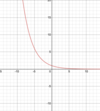MATH 112 Exam 1 Memorization Flashcards
(75 cards)
(a/b)x =
ax/bx
Domain and range of y = x3
- Domain: (-infinity, infinity)
- Range: (-infinity, infinity)

What is one important prerequisite for a function to have an inverse function?
ONE-TO-ONE
(i.e., only one x-value for each y-value)
Intermediate Value Theorem
The intermediate value theorem states that if f is a continuous function whose domain contains the interval [a, b], then it takes on any given value between f(a) and f(b) at some point within the interval.
Domain and range of y = mx + b
- Domain: (-infinity, infinity)
- Range: (-infinity, infinity)

When x < 0
1/x =
- sqrt 1/x2
When is it no helpful to multiply by the radical conjugate when evaluating limits?
When you are evaluating limits at infinity. Instead, you should divide by 1/xa where “a” is the greatest factor.

b


Domain and range of y = lxl
- Domain: (-infinity, infinity)
- Range: [0, infinity)

Log Base conversion:
loga x =
(logb x) / (logb a)
Definition of Continuity
- f(x) is continuous at x = a
- limit as x approaches a of f(x) exists (this means
- left limit must exist, right limit must exist, and they must be equal
- f(a) exists (i.e., a is in the domain; i.e., there is a y-value for it; i.e., it is defined)
In short, the limit as x approaches a for f(x) = f(a) – [and they both exist]
loga (m) - loga (n) =
loga (m/n)
ax • ay =
ax+y
sin(2x) = ?
2 sin x cos x
Limit Laws (and when they are true)
These laws do NOT apply when the limits do not exist! This includes when the limits are INFINITE! Infinite limits do not “exist”!!

tan(-x) = ?
tan x
45-45-90 Triangle

(when b<0 and n is even)

|b|
Domain and range of arctan x
- Domain: (-infinity, infinity)
- Range: (-π/2, π/2)

How to convert degrees to radians.

loga (m) + loga (n) =
loga (mn)


Domain and range of y = x2
- Domain: (-infinity, infinity)
- Range: [0, infinity)























